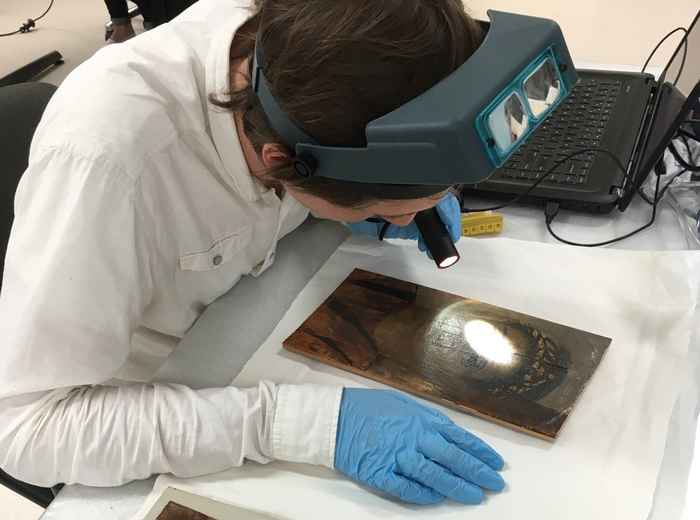Technical Art History

A new branch of Art History
Over the last two decades Technical Art History (TAH) has grown into an art historical subdiscipline of its own. Yet, it also contributes to the answering of all kind of other art historical questions such as dating, attribution, reconstructing original appearance, function, collecting, etc.
In the two-years Technical Art History track at the University of Amsterdam a small group of students work hands-on with a wide variety of art objects, using state-of-the-art analytical equipment to examine their construction and material composition. Lecturing includes courses with a historical perspective and courses dedicated to applied science. During the programme you will participate in several excursions, workshops, and the making of historical reconstructions.
A unique specialisation
Conservation and Restoration at the University of Amsterdam is one of the few programmes in the world to offer this specialisation, which sits at the crossroads between art history, conservation and science. The UvA is ideally situated to facilitate connections and internships with local museums and institutions, and to participate in relevant research projects.
Below you can see the (provisional) schedule of courses for the programme starting next academic year.
-
Technical Art History: Defining the fieldPeriod 16
-
Skill Building for Conservation I: Imaging and DocumentationPeriod 16
-
Chemistry of Materials in ArtPeriod 26
-
Theory, Ethics and Approaches in Technical Art History/ConservationPeriod 26
-
Art Technological Source ResearchPeriod 36
-
The World of Materials IPeriod 46
-
Imaging, Sampling and MicroscopyPeriod 46
-
Historical ReconstructionsPeriod 56
-
The World of Materials IIPeriod 56
-
Preventive Conservation: risk assessmentPeriod 66
-
Analytical Tools and TechniquesPeriod 16
-
Object Analysis: Scientific Examination and InterpretationPeriod 16
-
A Material History of ArtPeriod 26
-
Technical Art History: Field WorkPeriod 4Period 512
-
Free-choice electivesPeriod 26
-
Restricted-choice electives: Programme-specific electivesPeriod 36
-
Master's Thesis Conservation and Restoration of Cultural HeritagePeriod 4Period 5Period 618
-
Core courses
Courses within the specialisation Technical Art History teach you how the making of art has developed over time and how to investigate the material composition and physical condition of an art object. In a wider sense, you learn about the historical development of the TAH field and the role of the technical art historian in professional practice, next to those of the conservator, curator and scientist. You are trained to set up and perform art technological investigations based on the study of historical sources as well as of the objects themselves.
The science modules provide you with insights into the chemical and physical principles that determine the properties of materials in cultural heritage objects and those you might encounter on objects because of their use in conservation treatments, as well as the techniques available for the scientific analysis. Reconstruction classes offer a method to experience the art of making in order to understand the material composition and visual effects more fully. You are trained to investigate objects and document the results in writing, with the help of photography with different light frequencies, and with the use of digital tools for mappings. You furthermore learn to take samples from historical objects, process and study those in order to determine composition, technique and decay over time. Interactive modules are taught in a small group of maximum 8 TAH students, while in other modules you join the larger group of conservation students of your year (circa 20-24 students). Academic skill development emphasises argumentation, research and technical analysis skills, academic writing and presenting to different audiences.
All together, the track TAH familiarises you with an interdisciplinary approach in which knowledge from art history and the natural sciences, the analysis of samples and historical sources, and the use of scientific equipment are all combined in a unique curriculum that equips you for a position in the art world.
-
Electives
Students can choose an elective of 6 ECTS from the wide range of modules offered by the UvA and other Dutch universities. Electives contribute to the student’s insights in cultural heritage, humanities or science, broaden their perspectives and are usually offered by other disciplines such as archeology, computational science and philosophy. In addition, Conservation and Restoration offers students a choice of programme-specific electives in their second year (6 ECTS).
-
Internship
In the Fieldwork module, situated towards the end of the two years TAH programme, you work for four months in a Dutch museum or heritage institution in order to gain experience in the professional world outside the university.
-
Master's thesis
You write a thesis of 18 ECTS in the second year of the Master’s. The research topic will be determined in consultation with the thesis supervisor and can cover the whole array of research within the field of TAH. Theses may focus on a particular object or group of objects, and may involve object analysis, historical source research, and historical reconstructions amongst other methods. It is also possible that they rather have a historical or theoretical perspective.